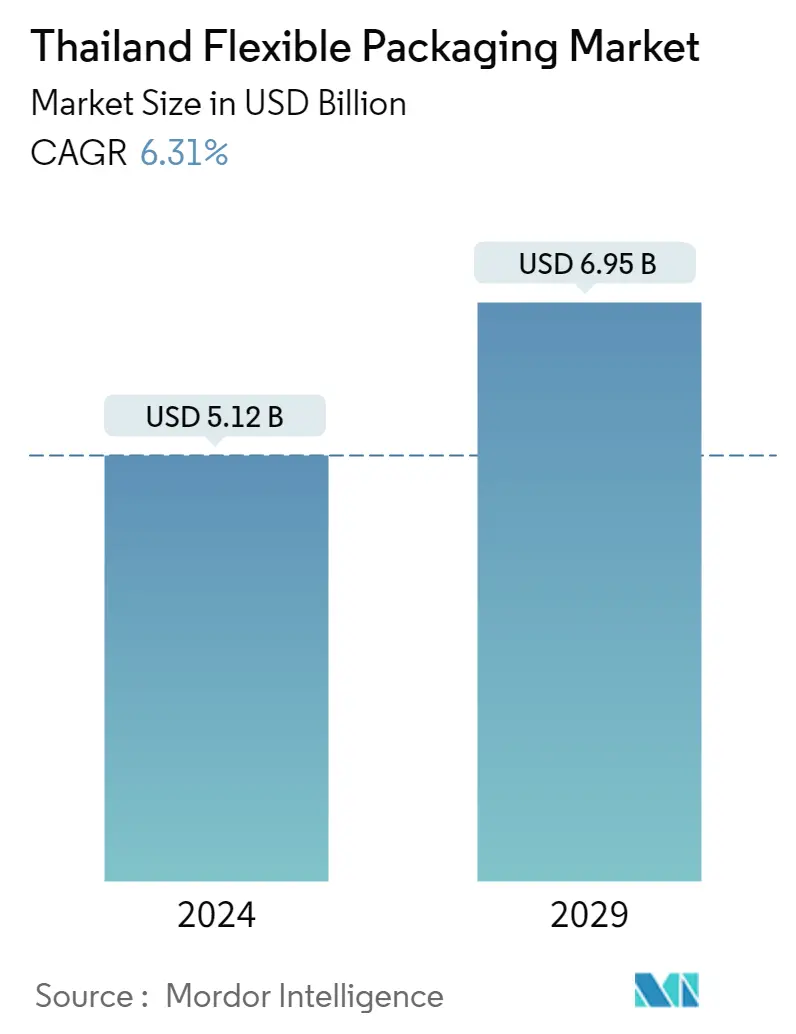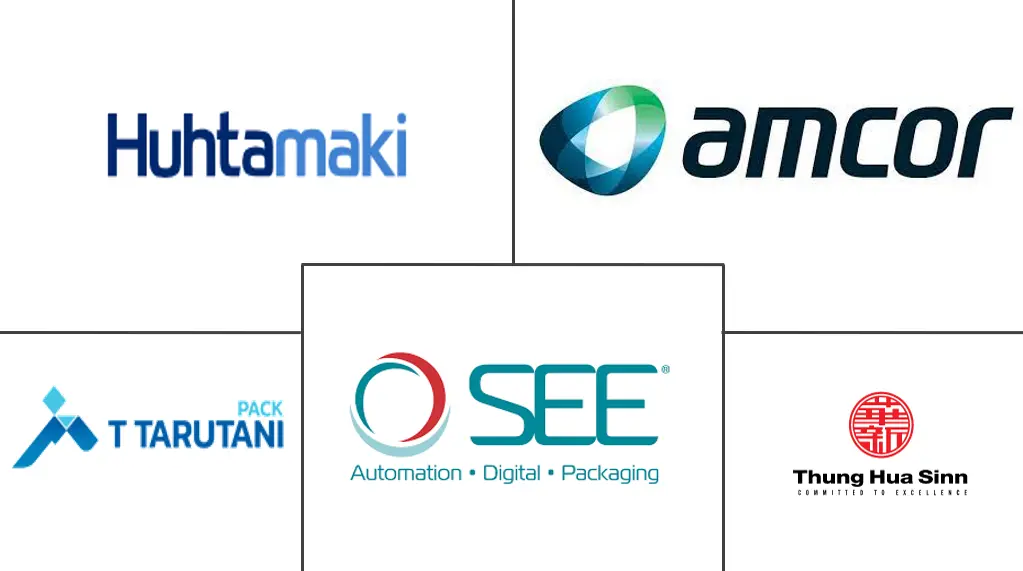Market Size of Thailand Flexible Packaging Industry

| Study Period | 2019 - 2029 |
| Base Year For Estimation | 2023 |
| Market Size (2024) | USD 5.12 Billion |
| Market Size (2029) | USD 6.95 Billion |
| CAGR (2024 - 2029) | 6.31 % |
| Market Concentration | Low |
Major Players
*Disclaimer: Major Players sorted in no particular order |
Need a report that reflects how COVID-19 has impacted this market and its growth?
Thailand Flexible Packaging Market Analysis
The Thailand Flexible Packaging Market size is estimated at USD 5.12 billion in 2024, and is expected to reach USD 6.95 billion by 2029, growing at a CAGR of 6.31% during the forecast period (2024-2029).
- The Thailand packaging sector rose steadily over the last decade due to changes in substrate preferences, the opening of new markets, and altering ownership dynamics. Sustainability and environmental issues are continually being raised, particularly in industrialized countries, and the sector is witnessing various technologies that cater to paper and plastic packaging. The rise of e-commerce and food delivery services, consumers' increasing demand for hygiene, convenience, and product safety, increased investment demand for extended shelf life, and changing lifestyles are the key causes pushing the country's market development post-COVID-19.
- Thailand's economic progress has resulted in a constant increase in flexible packaging product manufacturing and consumption. Thailand's flexible packaging industry is growing and contributing significantly to the country's economy. This expansion is driven by increased demand for flexible packaging materials that can be used to pack anything. According to International Monetary Fund, Thailand's gross domestic product at current prices is expected to rise by USD 192.8 billion (+33.58 percent) between 2023 and 2028. In 2028, the GDP is expected to be USD 767 billion.
- Consumers prefer plastic-based flexible packaging over other items because it is lightweight and unbreakable, making it easy to handle. Because of the cheaper production costs, even big firms favor plastic packaging. However, paper-based flexible packaging is predicted to increase fastest among all flexible packaging raw materials. This is primarily due to the trend towards environmentally friendly packaging. Paper packaging is likely to gain further from its use in online shopping. The pulp industry's exports will continue to grow.
- However, the increasing awareness about the environmental impact of single-use plastic and unsustainable business plastic solutions increased the demand for sustainable products that positively impact the environment. The initiative by local government bodies in Thailand raised awareness and significantly impacted plastic packaging consumption. According to World Bank, despite the high municipal solid waste collection and recycling rate of 88.8% in Thailand, the uncollected plastic waste results in an estimated 428 kilotons/year of mismanaged plastic waste. Due to large volumes of waste generated, Bangkok contributes 18.4% of exposed mismanaged plastic waste.
- The COVID-19 pandemic created a demand for good quality packaging for various end-user industries as the pandemic raised concerns about the ability of COVID-19 to survive on packaging surfaces. The pandemic, which resulted in nationwide lockdowns, had a far-reaching financial impact on the flexible packaging market in the early stages. However, this paved the way for cost-effective, sustainable, and easy-to-transport packaging material.
Thailand Flexible Packaging Industry Segmentation
Flexible packaging consists of bags and pouches that can be modified and are of free shape. The flexible packaging for commodity goods and services is witnessing a high volume, low margin offered by a polymer manufacturer. It includes a wide range of processes, ranging from extrusion, slitting, rewinding, printing, coating, and lamination.
The Thailand Flexible Packaging Market is segmented by Product Type (Pouches (Type (Stand-up, Flat), End-user (Food, Beverage, Pet Food)), Bags, Film-wraps (Type (BOPP, BOPET, CPP, PVC, PE) End-user (Food, Consumer Goods, Medical)). The market sizes and forecasts are provided in terms of value (USD) for all the above segments.
| Product Type | ||||||||||||||||
| ||||||||||||||||
| Bags | ||||||||||||||||
| ||||||||||||||||
| Other Product Types |
Thailand Flexible Packaging Market Size Summary
The Thailand Flexible Packaging Market has been growing steadily over the last decade due to changes in substrate preferences, the opening of new markets, and altering ownership dynamics. The rise of e-commerce, growing consumer demand for hygiene, convenience, and product safety, and changing lifestyles are key factors driving the market's growth. Additionally, increased investment demand for extended shelf life and the country's economic progress have led to a constant increase in the manufacturing and consumption of flexible packaging products. However, the increasing awareness of environmental impacts has led to a shift towards sustainable products and practices in the industry. The market is highly competitive, with a high number of market players and limited product differentiation. Innovation in design, technology, and application can provide a long-term competitive edge. The industry has seen significant developments, including the acquisition of Liquibox by Sealed Air Corporation and the launch of a new manufacturing facility by Amcor in China. The market is also witnessing a growing trend of lightweight and convenient packaging, and the food industry is expected to witness robust growth due to changing consumer habits and the rising demand for processed and packaged ready-to-eat meals.
Explore MoreThailand Flexible Packaging Market Size - Table of Contents
-
1. MARKET INSIGHTS
-
1.1 Market Overview
-
1.2 Industry Value Chain Analysis
-
1.3 Industry Attractiveness - Porter's Five Forces Analysis
-
1.3.1 Bargaining Power of Suppliers
-
1.3.2 Bargaining Power of Buyers
-
1.3.3 Threat of New Entrants
-
1.3.4 Threat of Substitute Products
-
1.3.5 Intensity of Competitive Rivalry
-
-
1.4 Assessment of Impact of COVID-19 on the Market
-
-
2. MARKET SEGMENTATION
-
2.1 Product Type
-
2.1.1 Pouches
-
2.1.1.1 Type
-
2.1.1.1.1 Stand-up
-
2.1.1.1.2 Flat
-
-
2.1.1.2 End-user
-
2.1.1.2.1 Food
-
2.1.1.2.2 Beverage
-
2.1.1.2.3 Pet Food
-
2.1.1.2.4 Other End-users
-
-
-
2.1.2 Bags
-
2.1.3 Films and Wraps
-
2.1.3.1 Type
-
2.1.3.1.1 BOPP
-
2.1.3.1.2 BOPET
-
2.1.3.1.3 CPP
-
2.1.3.1.4 PVC
-
2.1.3.1.5 PE
-
2.1.3.1.6 Other Types
-
-
2.1.3.2 End-user
-
2.1.3.2.1 Food
-
2.1.3.2.2 Consumer Goods
-
2.1.3.2.3 Medical
-
2.1.3.2.4 Other End-users
-
-
-
2.1.4 Other Product Types
-
-
Thailand Flexible Packaging Market Size FAQs
How big is the Thailand Flexible Packaging Market?
The Thailand Flexible Packaging Market size is expected to reach USD 5.12 billion in 2024 and grow at a CAGR of 6.31% to reach USD 6.95 billion by 2029.
What is the current Thailand Flexible Packaging Market size?
In 2024, the Thailand Flexible Packaging Market size is expected to reach USD 5.12 billion.
